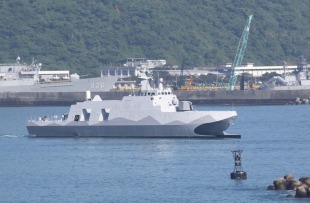Корвет Tuo Chiang (PGG 618)
Основная информация
Главные размерения
Машина
- MTU 20V 4000 M93L diesel engine – rated at 4,300 kW (5,766 bhp)
- 4 * MJP CSU 850 waterjet
Персонал
Боевые силы и средства
- Navigational Radar
- CS/SPG-6N(S) Surface Search Radar
- CS/SPG-6N(T) Fire Control Radar
- Variable Depth Sonar
- 12 counter-IR/RF chaff dispensers (6 bow and stern)
- 8 * Hsiung Feng II
- 8 * Hsiung Feng III
- 1 * Otobreda 76 mm
- 1 * Phalanx CIWS
- 2 * 12.7mm Browning M2HB
- 2 * Mark 32 triple torpedo launcher (one port and one starboard)
- Flight deck, primarily for VERTREP
The ROCS Tuo Chiang (PGG 618) is the fast (up to 45 knots, 83 km/h, 52 mph) and stealthy multi-mission corvette built for the Republic of China (Taiwan) Navy. It is designed to counter the numerous and increasingly sophisticated People's Liberation Army Navy ships by utilizing hit-and-run tactics, and thus featured clean upper structure design with very few extrusions to reduce radar signature, pre-cooled engine exhaust to reduce infrared signature, and a reduced visual signature to reduce chance of detection.
The ship is a catamaran design which is 60.4 metres (198 ft) long, 14 metres (46 ft) wide and carries a crew of 41 personnel. It is capable of a maximum speed of 40 knots and a range of 2,000 nautical miles (3,700 km; 2,300 mi). It is armed with eight subsonic Hsiung Feng II and eight supersonic Hsiung Feng III anti-ship missiles launchers, a Phalanx Close-In Weapons System, and a 76 mm (3 in) main gun. The ship can operate up to sea state 7 in waves up to 6.1-9.1 m high.
The ship increases its survivability in naval warfare by utilizing advanced stealth technology and low radar cross section (RCS), which makes it less detectable by radar and allows it to be obscure by background radar noise when operating closer to the coastline.
- Комментарии
 ru
ru en
en uk
uk



 Военно-морские силы Китайской Республики (Тайвань)
Военно-морские силы Китайской Республики (Тайвань) Lungteh Shipbuilding
Lungteh Shipbuilding